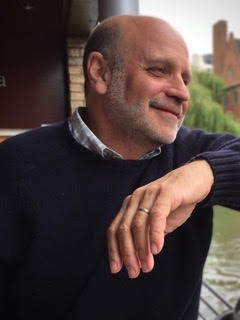Paul Orgel, Boston University (1980-1982)

I was 25 in 1980, had earned my Bachelors in piano performance at NEC, and then taken 3 years of rather punishing private lessons with one of Boston’s most prestigious piano teachers. I was teaching at The Music School at Rivers (now Rivers Conservatory), MIT, and a bit later, as a visiting teacher at Wesleyan University in Connecticut. Like far too many pianists determined to stay in Boston, I was trying to fashion some sort of teaching/performing career. I needed a Master’s degree.
Working on Debussy’s Études at the time, I happened upon di Bonaventura’s Connoisseur Society recording of them, also discovering his 2-LP Scarlatti Sonatas. These magnificent performances were the reason I applied to BU.
At my audition, Tony (which we all called him behind his back) told the story of his work on basic technique with Vengerova and offered me the option of playing no music for two years, working up to the perfect performance of a major scale.(!) He acknowledged that a graduate program might not be the right place to do this, and thankfully, found that my technical approach wasn’t too much of a hinderance. Among my assignments ahead of the first semester were the Scriabin 4th Sonata (his suggestion) and the Beethoven 4th Concerto. He asked me to memorize the left hand alone in both pieces, as a safeguard against memory problems, which I did, with great difficulty.
(I remember a pre- fall semester softball game where he pitched - carefully, underhand- to his students -- a happy, relaxed atmosphere that was unlike anything in my Oberlin or NEC experience with teachers.)
After I played a Bach Prelude and Fugue at my first lesson, his first words remain unforgettable: “I think I can help you with this.” I remember thinking at the time that, yes, that’s why I was there, and that I hadn’t heard a statement like that for the past three years. For the next two, I found him unfailingly helpful, pragmatic, and consistent in the values of piano playing that he wished to impart: clarity, above all, acute differentiation of voices, as little pedal as possible, absolute steadiness of rhythm, huge sensitivity to gradations of sound as notes moved from one to the next, little or no liberty with “taking time” unless it was meticulously planned. I remember his advice that, under no circumstance, should one make spontaneous, momentarily “inspired” choices in performance; stick to decisions made in advance! I believe that his philosophy was that interpretation should never be imposed on the music but would emerge from the highest possible level of craftmanship. He helped me with a great variety of repertoire: the Chopin 4th Scherzo, Schumann Carnaval and 8th Novelette, Bartók Improvisations, op. 20, Beethoven Opus 109 (his favorite Beethoven sonata), selected Debussy Etudes and Scarlatti sonatas, the Schubert D major sonata, and more.
Tony was a purist, perhaps lonely among his colleagues in the exalted, refined level of his concept of music-making. Among pianists, only Dinu Lipatti achieved the standard of playing that he strove for, though he once admitted to enjoying some of Artur Rubinstein’s performances. I think he particularly objected to Horowitz, who, of course, did more than anyone to program and record Scarlatti sonatas, but committed the crime of imposing his personality on his interpretations. (He also told me that there was no decent Italian cooking to be had in Boston, other than his wife’s).
As a pianist, I think that di Bonaventura was simply not as egotistical as most performers. I loved the untrendy eclecticism of his repertoire; (Rachmaninoff, Ginastera, lots of Scarlatti, French music, European avant garde composers) It was clear that he programmed exactly what music he wanted to play, not trying to prove anything. In Romantic or virtuoso repertoire (Rachmaninoff 3rd, Prokofiev 3rd, Chopin 3rd Sonata) it seemed to me that he was trying to expunge aspects of performance tradition- the exhibitionism - to bring a kind of objective clarity to the music.
Almost ten years after my Master’s at BU, I relocated to Philadelphia, and earned a DMA degree at Temple University. My teacher, Harvey Wedeen, was another Vengerova student whose ideas amplified di Bonaventura’s in many ways, though his approach allowed for more leeway in interpretation. (Harvey had also worked with Casadesus and, I think, Adele Marcus).
Musicians know that instruction doesn’t end when we no longer study with a particular teacher. Ideas lodge in our mind, gaining meaning later, sometimes emerging unpredictably. If we teach, our teachers’ teaching is a regular part of what we give to students at every lesson. It wasn’t until I was in my ‘50s and ‘60s, after decades of giving recitals that I began to feel that some of my performances were good, even praiseworthy. It took me that long to assimilate the teaching I had received from a varied array of teachers, and indirectly, from their teachers (Rudolph Serkin, Eduard Steuermann). Above all, I’m thankful for the exposure to Vengerova’s concepts that I gained from di Bonaventura and Wedeen, and ever grateful for Tony’s impeccable standards and kind treatment.
- Log in to post comments
